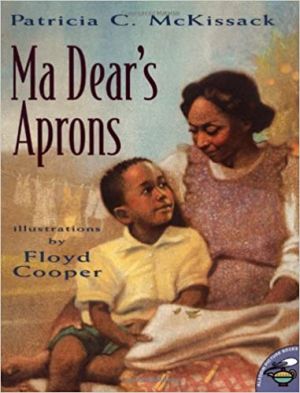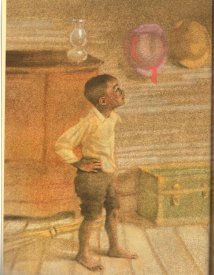Ma Dear's Aprons
Ma Dear's Aprons was written by Patricia C. McKissack and illustrated by Floyd Cooper. Patricia C. McKissack was the Newbery Honor, Coretta Scott King Award-winning author of The Dark-Thirty and Porch Lies an ALA Notable Book. She collaborated with Jerry Pinkney on Goin' Someplace Special (Coretta Scott King Award winner) and Mirandy and Brother Wind (Coretta Scott King Award winner and Caldecott Honor Book). [1]
Summary
Little David Earl always knows what day of the week it is. He can tell by the clean, snappy-fresh apron Ma Dear is wearing -- a different color for every day. Monday means washing, with Ma Dear scrubbing at her tub in a blue apron. Tuesday is ironing, in a sunshine yellow apron that brightens Ma's spirits. And so it goes until Sunday, when Ma Dear doesn't have to wear an apron and they can set aside some special no-work time, just for themselves. [2]
Pros
A compilation comments from Good Read's members can be found on their site. Most of them gave the compliments to this book, like Amy Layton, who rated this book five stars, she thought that this book celebrates the hard work of a single black mother and the little things in life that cheer both her and her son up. Though routine and at times monotonous, Ma Dear and her son's life is a content one, filled with hard work and an appreciation for what they have. Using Ma Dear's aprons as a means to celebrate their family and their hard work is such a nice way of showing how work and pleasure can intertwine, though they don't often do. It is recommended for kids grades 1-3. Other reader said that it was a beautiful book that addresses the struggles of an African American single mother and her son in what appears to be the 19th century. It would be great to use for working on character perspective and also in a history unit that focuses on the African American or Caucasian divisions of the time period. It was a thoughtful, engaging story about the relationship between a young boy and his single, working mother. The story takes us back to the time when there were horse-drawn wagons, washboards instead of washing machines, and the act of doing laundry was a time consuming process. Students reading this book will be amazed at how life was for a family in the first half of the 20th century. Since the story is told from the little boy's point of view, students can relate to his feelings of boredom, excitement, and love as the story progresses. [1]
Kirkus stated that McKissack's story looks at a week in the life of a turn-of- the-century African-American boy and his mother. With the aid of Cooper's paintings, McKissack gives real bite to the life of domestic workers 100 years back. This isn't a candy- coated mother-son relationship—Ma Dear is just as quick to tell David Earl ``no more buts, and stop whining, as she is to bestow a hug. [3]
"The real story is Ma Dear's. Children who have this book read to them will see an African-American woman whose life in the rural south of the early 1900s was difficult but lived with dignity and joy, stated School Library Journal. [4]
A review by Etta Wilson was made on one of online site, she wrote that Scattered through the week and the story were little bits about Ma Dear and David Earl that tell us much more about the rich relationship between mother and son than about the chores that made wearing an apron a necessity. Ma Dear pulls a clothespin from her pocket, and it became a brave soldier standing at attention "who died fighting out West" (the boy's father). As Ma Dear and David Earl go to clean a mansion, she pulls a piece of string from her apron pocket and teaches him how to make a Jacob's ladder. Floyd Cooper's soft, warm illustrations capture the bond between mother and child so well. Cooper tells us that he used his wife and young son as models for Ma Dear and David Earl, and on many pages, our eyes are drawn to the faces of the two characters. In his muted backgrounds we see oil lamps, a dish cabinet, wash tubs and a grand piano of the period, but the focus is always on the mother and son. [5]
References
- ↑ Jump up to: 1.0 1.1 Ma Dear's Aprons. Retrieved February 10th, 2021
- ↑ Ma Dear's Aprons. Retrieved February 10th, 2021
- ↑ MA DEAR'S APRONS. Retrieved February 10th, 2021
- ↑ [1]. Retrieved February 10th, 2021
- ↑ Ma Dear's Aprons by Etta Wilson . Retrieved February 10th, 2021


